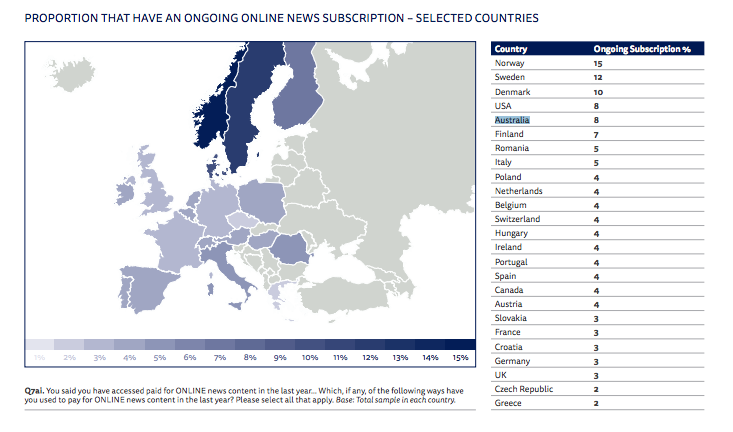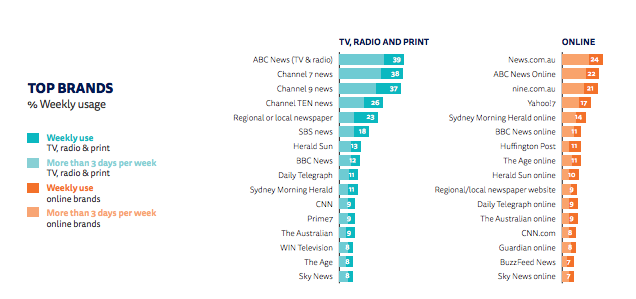Only 13% of Australians would pay for online news content, Reuters study suggests
Just 13% of the Australian population are prepared to pay for online news content, while 8% of Australians have ongoing online news subscriptions, the 2017 report on digital news by the Reuters Institute has revealed.
The study, which involved a YouGov online questionnaire across 36 countries conducted at the end of January to the beginning February 2017, suggested less than one in 10 Australians would pay for online news content.
The proportion of people who have paid for news in the past 12 months was higher in Nordic countries, including Norway, Sweden and Denmark, however Australia placed eighth, with less than 15% of Australian consumers paying for news over the same time period.
When asked for a primary reason they would consider paying for news, 25% of the Australian sample (2,000) said funding journalism would be a primary motivator.

Despite the lack of Australians willing to pay for news, traditional print brands, such as The Australian, The Daily Telegraph, The Sydney Morning Herald and The Age are still read online by almost half of Australia’s sample.
The most-used online news brand in Australia was news.com.au at 24%, with ABC News Online and nine.com.au to follow at 22% and 21% respectively.
Among the TV, print and radio category, ABC News TV and Radio was the top brand at 39%, ahead of Channel Seven News at 38% and Channel Nine News at 37%.
Channel Ten placed fourth at 36% while SBS news was the sixth-most-used brand across TV, radio and print, reporting a share of 18%.
More than 40% of Australians reported online as their main source of news, ahead of TV, at 36%.
The study also reported a 4 percentage point increase in mobile news notifications for Australians – up to 12% of the population.
Australians are also using news applications more frequently, up from 16% in 2016 to 23% in 2017.
In Australia, social media has declined as a source of news by six percentage points, with only 46% of Australians using it as a way to access news.
However according to the latest survey from Reuters, almost one quarter of Australians use ad-blockers.
The top countries for ad-blockers include Greece, Poland, France and Argentina, with more than 30% of the samples in these countries using ad-blocking software.
58% of those who turned off their ad-blockers did so as it was the only way to view the website or its content, while 43% have temporarily disabled their ad-blocker specifically for news purposes.
Other results suggested general trust in news media was relatively stable in Australia, at 42%, however 56% of respondents said they avoided the news sometimes, often or occasionally.
Compared to other countries in the survey, Australia’s trust in the media was mid range, with Finland the country with the most trust in its media (62%) and Korea and Greece the countries with the lowest trust (23%).
Despite this year’s discussions around fake news, 38% of the United States trust the sources they use and the United Kingdom sits at 43%.
The report also indicated women tend to avoid news more often than men, with a key reason being news has a negative impact on mood.
According to the survey, 31% of Australians believe the media is free from political influence while 28% believe media is free from business influence.
Commentary from Caroline Fisher, Jerry Watkins and Michelle Dunne Breen at the News & Media Research Centre at the University of Canberra in the report, noted how changes which have occurred in the past year or were about to occur – including redundancies, business restructures, the severing of Nine’s programming agreement with WIN, the proposed sale of Fairfax Media, and the proposed media reforms – were likely to change Australia’s media landscape.
“All these changes are taking place against the backdrop of a proposed relaxation of cross-media ownership rules announced by the centre-right Turnbull government in March 2016. Alongside the public broadcasters ABC and SBS, Australia’s traditional media environment includes three commercial terrestrial TV networks, the Foxtel cable/satellite/IPTV network plus multiple commercial radio networks. Current regulation blocks any single entity controlling more than two of out of three traditional platforms (commercial radio, commercial television, and associated newspapers) within one commercial radio licence area – the so-called two out of three rule.
“Relaxation of this rule could open the door to mergers between national and regional TV stations as well as rationalisation of the commercial radio market.
“The likely impacts on plurality and diversity of voice are harder to discern. On one hand Australia already features one of the highest concentrations of print ownership of any Western democracy, with only two main players – News Corp Australia and Fairfax.
“Others argue that Australia’s high level of smartphone penetration and near-universal internet access in urban areas mean that plurality and diversity are already delivered via online, mobile, and social platforms to the majority of the population.
“Although internet advertising continues to move online – one PwC forecast sees it rising to 51% of the total ad market spend by 2020 – these revenues are not enough to compensate for accelerating loss of revenues from print.
“Local news brands also face increased competition from overseas brands, which have developed a significant Australian presence including local versions of UK mastheads the Guardian (2013) and the Mail Online (2014) as well as American sites BuzzFeed (2014) and the Huffington Post (2015).”







Where do they think content come from, the magic free tree over the rainbow?